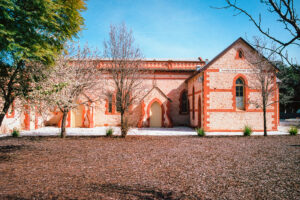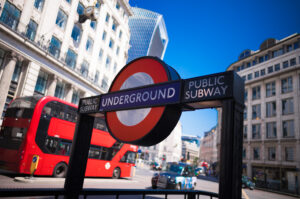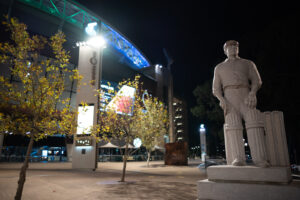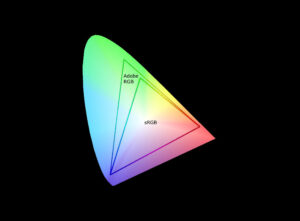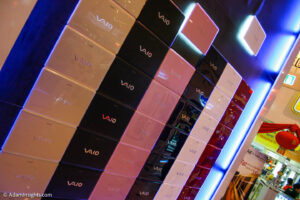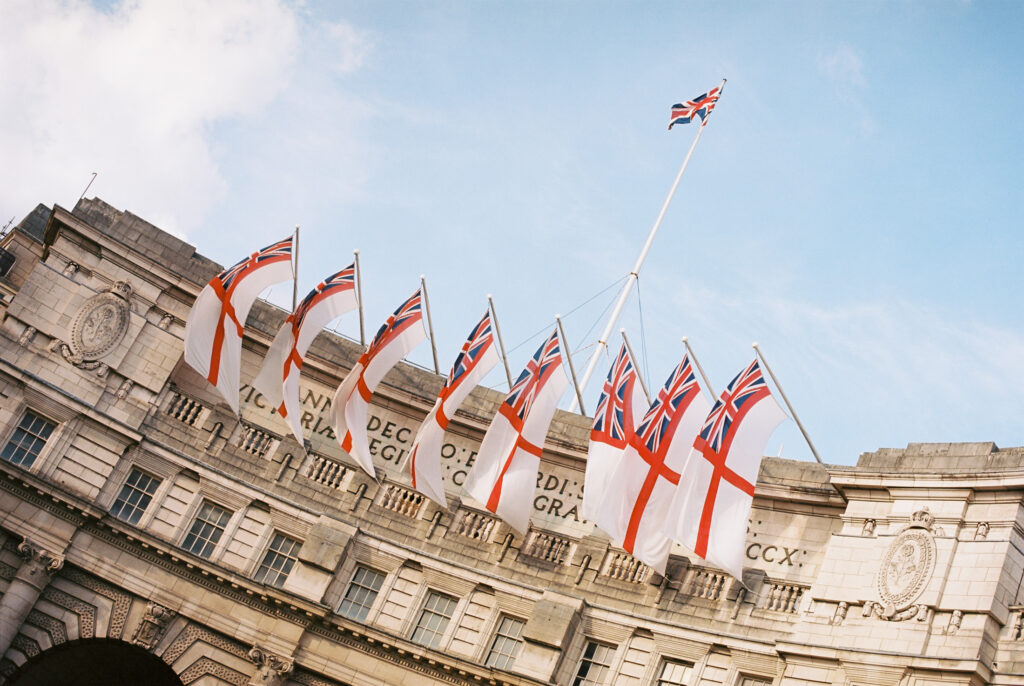The White Ensign, historically referred to as the St George’s Ensign due to the concurrent existence of a crossless variant of the flag, serves as the ensign adorning British Royal Navy vessels and shore establishments. It comprises a red St George’s Cross placed upon a white field, essentially mirroring the flag of England, except featuring the Union Flag in the upper canton.
Beyond its association with the United Kingdom, the White Ensign finds application in other nations, where it may exhibit variations tailored to their respective national flags in the canton. In certain instances, the St George’s Cross may be substituted by a naval badge that entirely omits the cross. Notably, yachts affiliated with the Royal Yacht Squadron, along with ships belonging to Trinity House during the escort of the reigning monarch, also adopt the White Ensign.
For instance, the Royal Irish Yacht Club employs a white ensign embellished with an Irish tricolour positioned in the first quadrant, accompanied by the crowned harp derived from the Heraldic Badge of Ireland. In the case of the Flag of the British Antarctic Territory and the Commissioners’ flag of the Northern Lighthouse Board, the Union emblem occupies the first quarter of a white field, thereby excluding the encompassing red St George’s Cross. However, it is crucial to note that these particular variants are not intended for employment as ensigns during maritime activities.
At Admiralty Arch
Admiralty Arch, a prominent architectural landmark situated in Trafalgar Square, London, holds a longstanding tradition of being adorned with white ensigns during momentous state occasions. This iconic structure, with its commanding presence and historical significance, has become a symbol of national pride and maritime heritage.
The practice of embellishing Admiralty Arch with white ensigns holds deep-rooted historical and cultural significance, dating back to the era when Britain’s naval supremacy played a pivotal role in shaping the nation’s identity. The white ensign, representative of the British Royal Navy, carries a rich legacy as a symbol of maritime prowess and national defence.
During state occasions, which often encompass important ceremonies, celebrations, and royal events, the display of white ensigns at Admiralty Arch serves as a vivid visual expression of the nation’s maritime heritage and the integral role of the Navy in protecting and projecting British interests across the globe.
The choice of white ensigns, distinct with their prominent St George’s Cross and Union Flag in the canton, evokes a sense of continuity with centuries-old maritime traditions. This resonant symbolism not only pays tribute to the naval heroes of the past but also honours the valour and dedication of the present-day men and women serving in the Royal Navy.
Moreover, the decoration of Admiralty Arch with white ensigns serves as a unifying and patriotic gesture, fostering a sense of national pride among the populace and instilling a collective appreciation for the country’s maritime history and enduring naval legacy. The sight of fluttering white ensigns against the grand backdrop of Admiralty Arch creates a powerful visual spectacle, evoking feelings of reverence and admiration for the nation’s naval heritage.
History of the White Ensign
During the 16th century, the inception of English naval ensigns marked a significant development in maritime heraldry. Originally, these ensigns exhibited distinctive stripes in the Tudor colors of green and white, with additional colours like blue, red, and tawny brown employed to signify various squadrons. Historical artworks, such as contemporary paintings depicting the 1588 Spanish Armada battles, bear witness to the usage of these striped ensigns on both English and Spanish warships.
Over time, modifications were made to the design of these ensigns. By the early 17th century, a recognizable White Ensign emerged, characterized by a white field, bearing a broad St. George’s Cross and a smaller version of the same cross in the canton. Similar adaptations were applied to the red and blue ensigns of that period. However, around 1630, the white ensign underwent further alterations, featuring solely a white field with a diminutive St. George’s Cross in the canton.
In 1707, the St. George’s Cross was reintroduced to the entire flag, albeit in a narrower form, and the Union Flag found its place in the canton. A version without the overall St. George’s Cross also existed but appeared to be limited to use in domestic waters, eventually falling out of favour by 1720. Subsequent changes occurred after the Act of Union in 1800, wherein the flag was updated to include the new Union Flag in the canton, assuming the form familiar today. As a measure to extend the flag’s longevity and prevent frequent replacements due to fading, the blue field of the Union Flag was darkened at the request of the Admiralty.
Throughout this era, the proportions of the flags underwent several adjustments. For instance, in 1687, Secretary of the Admiralty Samuel Pepys mandated a ratio of 11:18 for the flags (18 inches in length for each breadth of 11 inches at that time). Later, in the early 18th century, the breadth was reduced to 10 inches, resulting in a ratio of 5:9. The final reduction took place in 1837 when the breadth was set at 9 inches, establishing the current ratio of 1:2.
During this historical period in the Royal Navy’s evolution, the White Ensign constituted one of three ensigns in use, each assigned to a specific squadron of the navy, denoted by its colour (red, white, and blue, with red indicating the most senior and blue the least). Ships displayed the ensign corresponding to the squadron they belonged to, which was determined by the seniority of the admiral under whose command the vessel operated (e.g., a rear admiral of the red was superior to a rear admiral of the white).
To address ambiguity arising from the Red Ensign serving as both a civil and naval ensign, the Admiralty decided in 1864 to reserve the White Ensign exclusively for the Royal Navy. An Order in Council was issued, providing the option to use Red or Blue Ensigns on HM Ships if preferred. This decision streamlined the use of ensigns and clarified their roles within the naval and civil contexts.
Current Use
UK
Royal Navy vessels, both ships and submarines, proudly display the White Ensign while underway on the surface. This distinctive flag may also be hoisted on a gaff and shifted to the starboard yardarm during sea voyages. When alongside, the White Ensign takes its position at the stern of the ship, while the Union Jack flag is flown as a jack at the bow, exclusively during daylight hours. The Royal Navy’s emblem features a fluttering White Ensign at its pinnacle.
On special occasions, such as the King’s birthday or commemorative events, Royal Navy ships don the White Ensign at the mastheads, an emblematic display symbolizing the significance of the occasion. Foreign warships visiting British waters may likewise adopt this practice, as a mark of respect during British holidays or while rendering salutes to British authorities. Additionally, boats of commissioned ships and yachts affiliated with the Royal Yacht Squadron and Trinity House, during their escort duties for the British Monarch, are also authorized to display the White Ensign.
On land, the White Ensign graces all naval shore establishments, including those of the Royal Marines, emphasizing their status as commissioned warships. Special permissions have been granted to certain buildings with naval connections, such as St Martin-in-the-Fields Anglican Church in Trafalgar Square, London, which serves as the parish church of the Admiralty. Notably, the Cenotaph, a significant memorial, exhibits the White Ensign alongside the Union Jack flag (representing the British Army) and the Royal Air Force Ensign, paying tribute to the fallen heroes of the World Wars.
Particular events have seen exceptional permissions granted for individuals or organizations to fly the White Ensign, as exemplified by the commemoration of Trafalgar Day and the victory in the naval Battle of Trafalgar on its 201st anniversary in 2006.
Interestingly, the U.S. Navy destroyer Winston S. Churchill has the unique distinction of flying both the White Ensign and the Stars and Stripes, as a tribute to its namesake, the former British Prime Minister. Moreover, Isambard Kingdom Brunel’s SS Great Britain, though originally a merchant ship, continues to bear and fly the White Ensign, preserved in dry dock as a historical exhibit and museum ship, owing to its first master, who was a former Royal Navy personnel and brought the ensign with him.
In the Commonwealth
Historically, the White Ensign was utilized in its original form by the naval forces of Australia, Canada, and New Zealand, while the Blue Ensign of each Dominion served as a jack. However, in 1965, with the adoption of the Maple Leaf Canadian flag, Canada ceased using the White Ensign on its naval vessels in favour of the new flag. Subsequently, in 1968, after a reorganization of the Canadian armed forces, a new “white ensign” was introduced, featuring the Canadian flag in the canton and a badge in the fly. Initially, this flag was used as the jack and formed the basis of the sovereign’s colours for the Royal Canadian Navy. In May 2013, the Canadian “white ensign” took precedence as the ensign, while the national flag became the jack. Nonetheless, many Canadian veterans’ organizations continue to unofficially use the original White and Blue Ensigns as symbolic representations of their history and heritage.
During Australia’s involvement in the Vietnam War, the Royal Australian Navy (RAN) modified the White Ensign in 1967 to create a distinct Australian ensign, thereby avoiding any confusion with UK vessels, as Britain was not engaged in the conflict. New Zealand followed suit in 1968. These modified RAN and RNZN White Ensigns retain the Union Flag in the first quarter, but instead of St. George’s Cross, they incorporate the Southern Cross designs from each nation’s flag (blue stars for RAN and red stars for RNZN).
Numerous other Commonwealth navies also exhibit naval ensigns with visual connections to the White Ensign. For instance, the South African Navy has retained a cross on a white field, complemented by their national flag in the canton, replacing the Union Flag. The Royal Indian Marine (renamed Royal Indian Navy in 1934) used the unaltered White Ensign as its ensign from 1928 until 26 January 1950, when India became a republic within the Commonwealth. After this date, the Royal Indian Navy transitioned to the Indian Navy, replacing the Union Jack in the canton with the Indian tricolour.
These modifications to the White Ensign among various Commonwealth navies exemplify the evolving historical and cultural contexts in which these flags have been used and adapted over time.



